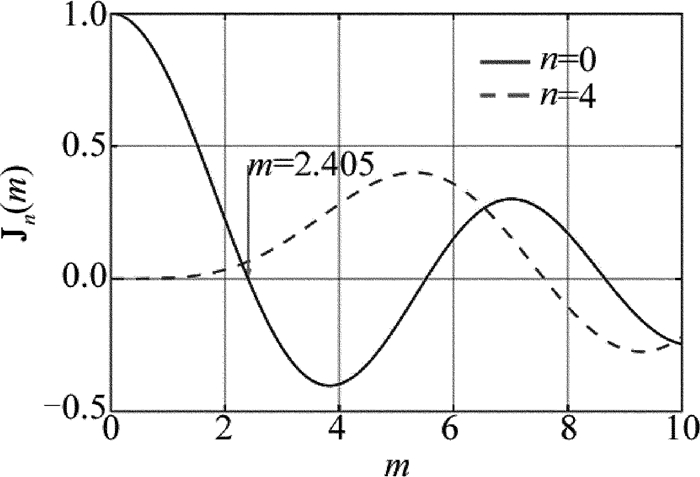HTML
-
近些年来,利用微波光子技术生成微波毫米波等高频信号的技术成为热点[1-5],该技术已经成功应用到了诸如医学成像、雷达、无线通信等领域,相比于传统的电学方法生成高频信号的技术,光生微波毫米波信号具有频率高、带宽大、频谱纯度高且不易受电磁干扰等优势。
光生微波毫米波信号有很多技术,其中外调制技术系统简单、稳定性高且频率调谐性好,成为最具吸引力的方法。当前,针对四倍频[6-9]、六倍频[10-12]、八倍频[13-19]、十二倍频[20-22]微波毫米波信号生成的方案已经进行了广泛而深入的研究,更高倍频因子的方案也相继被提出。参考文献[23]中报道了采用级联双平行马赫-曾德尔调制器(dual-Mach-Zehnder modulator,DP-MZM)生成十六倍频光生毫米波的方案,系统复杂。参考文献[24]中报道了基于DP-MZM和光滤波器生成十六倍频的方案,相比于参考文献[23], 该方案更加复杂。参考文献[25]中报道了基于级联调制器的二十四倍频毫米波信号产生,该方案使用了一个DP-MZM、一个MZM,链路不止一个光电探测器(photodetector,PD),系统也很复杂。
在参考文献[20]中,SHIH等人提出了基于DP-MZM与半导体光放大器(semiconductor optical amplifier,SOA)结合的十二倍频方案,生成了较高频率的信号。本文中将在SHIH等人所提方案的基础上,提出一种基于并联MZM和SOA结合生成二十四倍频毫米波信号的方案,鉴于光纤布喇格光栅(fiber Bragg grating,FBG)体积小、插入损耗低以及与普通通信光纤良好匹配的特点,本方案用FBG代替SHIH等人所用的梳状滤波器,可以实现二十四倍频本振信号的生成。将两个MZM都偏置在最小传输点(minimum transmission point, MATP),通过设置其它参量以及调节调制指数生成±4阶边带,利用SOA的四波混频(four-wave mixing, FWM)效应生成±12阶边带,然后滤除±4阶边带后进行拍频,从而生成二十四倍频信号。
-
所提出的二十四倍频方案如图 1所示。本方案中所用到的器件有连续激光器、射频(radio frequency, RF)信号源、直流源、马赫-曾德尔调制器、偏振控制器、半导体光纤放大器、相位移相器(phase shifter, PS)、布喇格光栅滤波器、光学衰减器(optical attenuator, OA)以及光电探测器。
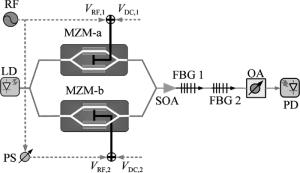
Figure 1. Schematic diagram of microwave millimeter wave signal generation based on parallel MZM structure and SOA
设抽运激光器发出的光信号和微波源发出的电信号分别为:
式中,E0是光场幅度,ω0是抽运光波频率,VRF是射频信号的幅度,ωRF是射频信号的角频率。
入射进两个子调制器的直流偏置电压用VDC, i(i=1, 2)表示,则由直流偏置所引入的相位差ϕi=πVDC, i/Vπ(i=1, 2),其中Vπ是MZM的半波电压。
激光器发出的光波被一个马赫-曾德尔集成调制器所调制,该集成调制器由嵌入到MZM上下两臂的两个子调制器MZM-a和MZM-b构成。射入两个子调制器的射频信号相位相差π/2,每个子调制器的上下两臂的射频信号相位差为0。令MZM-a和MZM-b都偏置在MATP,即ϕ1=ϕ2=0,则经过并联MZM调制后的信号可以表示为:
当$ \Delta \phi = \frac{{\rm{ \mathsf{ π} }}}{2}$时,(3)式可化为:
式中,Jn(m)为n阶贝塞尔函数。
由(1)式~(4)式可知:(1)当n=4k+1或n=4k+3(k为整数,下同)时,1+(-1)n=0,±1阶和3阶边带信号被抑制;(2)当n=4k+2时,1+jn=0,±2阶边带信号被抑制;(3)当n=4k时,Eout(t)≠0,载波和±4阶边带信号被保留,更高阶的信号由于功率过低,可以不用考虑。
令J0(m)=0,可抑制载波,如图 2所示。当m=2.405时,J0(m)=0。
当满足频率稳定、相位相关且偏振态相同的两个光波信号在非线性介质中传播时,会由于非线性极化作用发生混频效应,从而产生两个新的波长,这种现象被称为FWM。设抽运光频率为ω0,信号光频率为ω1,则经FWM效应后生成的两个谐波分量的频率分别为(2ω0-ω1)和(2ω1-ω0),如图 3所示。
诸如高非线性光纤(high nonlinear optical fiber, HNLF)和SOA等非线性器件都可以发生FWM、交叉增益调制(cross gain modulation, XGM)、交叉相位调制(cross phase modulation, XPM)等非线性效应。FWM的产生要求各信号光的相位匹配,当各信号光在光纤的零色散附近传输时,材料色散对相位失配的影响很小,因而较容易满足相位匹配条件,容易产生四波混频效应。本方案中,从DP-MZM中产生的光信号满足频率稳定、相位相关等条件,此时,其它的非线性效应的影响很小,可以忽略不计。因此,将采用SOA进行FWM。
如前面所述,生成的±4阶边带信号在经过FWM后将产生±12阶边带信号,分别为ωidler, 1=2ω0-ω1=-12和ωidler, 2=2ω1-ω0=+12。经两级FBG滤除±4阶边带信号后,只剩下±12阶边带信号,最后经PD拍频便可生成纯净的二十四倍频信号。
-
针对提出的二十四倍频信号生成方案,作者利用OptiSystem软件进行了仿真实验。
如图 1所示,连续激光器发出的光信号中心频率为193.1THz,功率为0dBm,线宽为10MHz;射频源信号频率为5GHz,初始相位为0;MZM-a和MZM-b参量设置一样,消光比为50dB,半波电压为4V,插入损耗为5dB,设置射频调制电压为6.127V,直流偏置电压为4V和0V;SOA注入电流为0.08A;FBG 1中心频率为193.12THz,带宽为35GHz,FBG 2中心频率为193.08THz,带宽同样为35GHz; 光学衰减器衰减量为5dB, 光电探测器增益为20;响应度为5A/W。
如图 4a所示,在设置消光比为50dB的情况下,并联MZM输出的频谱图中±4阶边带信号占据主导,而其它谐波则被极大的抑制,虽然仍有±1阶边带信号,但光学边带抑制比(optical sideband suppression ratio,OSSR)仍然达到了35dB。图 4b显示了经SOA混频后的频谱图。可以看到, 由于FWM效应生成了±12阶边带信号。图 4c显示了经两级FBG滤除±4阶边带后的频谱图,OSSR为29dB。图 4d为PD输出的二十四倍频信号电谱图。由图可知,在输入射频信号5GHz时,生成了120GHz的微波信号,且射频杂散抑制比(radio frequency spurious suppression ratio,RFFSR)为22dB,具有很高的纯度。
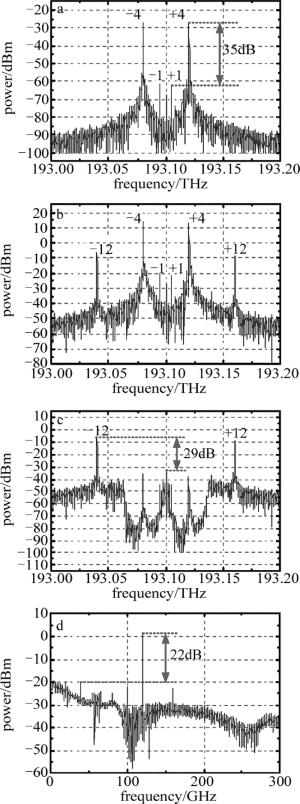
Figure 4. a—output spectrum of parallel MZM b—output spectrum of SOAc—output spectrum of FBG 2 d—output electricity spectrum of PD
为了验证二十四倍频方案的频率可调谐性,调整射频信号的频率,观察PD输出的电谱图如图 5所示。由图 5可知,当射频信号在4GHz~7GHz之间调谐时,所生成的二十四倍频信号仍然具有很高的RFFSR,说明该二十四倍频结构可以实现获得96GHz~168GHz的高频微波信号。
-
本文中介绍了一种基于并联MZM和SOA结合实现输入信号二十四倍频的方案,在输入信号为5GHz时,生成了120GHz的高频微波信号,RFFSR为22dB,当输入信号频率在4GHz~7GHz范围内调节时,可以获得96GHz~168GHz的高频微波信号,频谱纯度也很高。从理论上分析验证了该方案实现二十四倍频的可行性,为高频微波毫米波信号的生成提供了更高的倍频方法。本方案虽然可以生成较高倍频数的信号,但是信号的RFSSR也只维持在22dBm的水平,相较于已有的四倍频、八倍频信号的RFSSR可以达到30dBm以上、甚至40dBm以上的水平,本方案还有所差距。所以,既要考虑高倍频因子,也要考虑信号的高性能,这是以后努力的方向。

 Map
Map


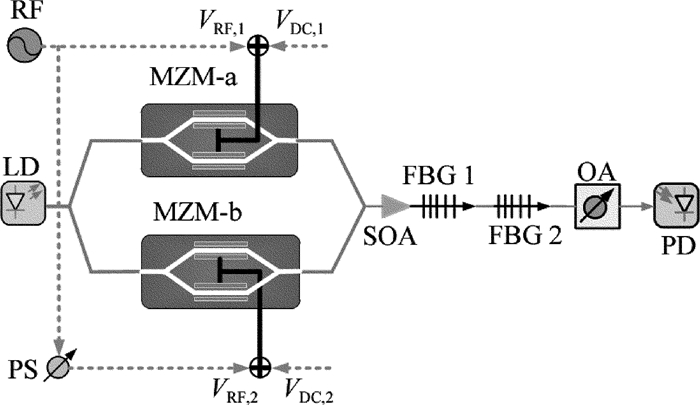



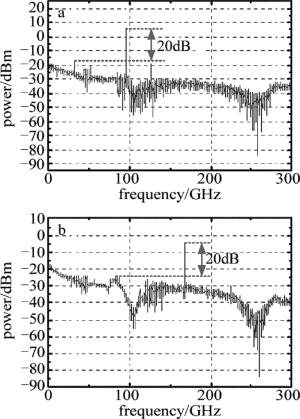
 DownLoad:
DownLoad:
